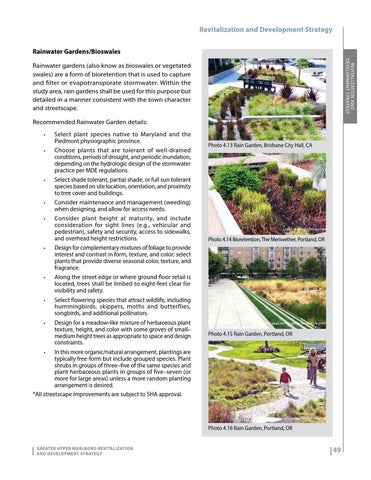Revitalization and Development Strategy Rainwater Gardens/Bioswales revitalization and development strategy
Rainwater gardens (also know as bioswales or vegetated swales) are a form of bioretention that is used to capture and filter or evapotransporate stormwater. Within the study area, rain gardens shall be used for this purpose but detailed in a manner consistent with the town character and streetscape. Recommended Rainwater Garden details: ••
Select plant species native to Maryland and the Piedmont physiographic province.
••
Choose plants that are tolerant of well-drained conditions, periods of drought, and periodic inundation, depending on the hydrologic design of the stormwater practice per MDE regulations.
••
Select shade tolerant, partial shade, or full sun tolerant species based on site location, orientation, and proximity to tree cover and buildings.
••
Consider maintenance and management (weeding) when designing, and allow for access needs.
••
Consider plant height at maturity, and include consideration for sight lines (e.g., vehicular and pedestrian), safety and security, access to sidewalks, and overhead height restrictions.
••
Design for complementary mixtures of foliage to provide interest and contrast in form, texture, and color; select plants that provide diverse seasonal color, texture, and fragrance.
••
Along the street edge or where ground floor retail is located, trees shall be limbed to eight-feet clear for visibility and safety.
••
Select flowering species that attract wildlife, including hummingbirds, skippers, moths and butterflies, songbirds, and additional pollinators.
••
Design for a meadow-like mixture of herbaceous plant texture, height, and color with some groves of small– medium height trees as appropriate to space and design constraints.
credit: www.nevuengan.com
Photo 4.13 Rain Garden, Brisbane City Hall, CA
credit: www.sitephocus.com
Photo 4.14 Bioretention, The Meriwether, Portland, OR
credit: the pearl district guide (www.flickr.com)
Photo 4.15 Rain Garden, Portland, OR
••
In this more organic/natural arrangement, plantings are typically free-form but include grouped species. Plant shrubs in groups of three–five of the same species and plant herbaceous plants in groups of five–seven (or more for large areas) unless a more random planting arrangement is desired. *All streetscape improvements are subject to SHA approval.
credit: Portland Urban Condos (www.flickr.com)
Photo 4.16 Rain Garden, Portland, OR
|
Greater Upper Marlboro Revitalization and Development Strategy
| 49
